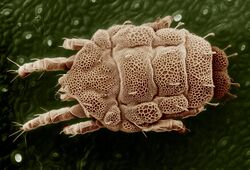Biology:Tydeidae
| Tydeidae | |
|---|---|

| |
| "Yellow mite", Lorryia formosa | |
| Scientific classification | |
| Kingdom: | |
| Phylum: | |
| Class: | |
| Subclass: | |
| Order: | |
| Superfamily: | Tydeoidea
|
| Family: | Tydeidae Kramer, 1877
|
| Subfamilies | |
| |
| Diversity | |
| 30 genera, >320 species | |
Tydeidae is a family of acariform mites. As of 2016, it contained over 300 species in three subfamilies,[1] though more species have been discovered since then.[2]
These mites live in a wide range of habitats and there are predatory, fungivorous and scavenging species.
Description
Tydeidae are soft-bodied mites with an idiosoma that is striated, reticulated or a combination of both. They have two bothridial setae. The chelicerae have fused bases, a movable digit that is relatively short and needle-like, and a fixed digit that is reduced. They may have two or three eyes, though some species are blind.[1]
Of the three subfamilies, Pretydeinae has no setae on the genu of legs II, III or IV, and the palptarsus has a triple eupathidium at the end. The other two subfamilies have one or two setae (Tydeinae) or three setae (Australotydeinae) on the genu of leg II, and the palptarsus ends in a double or triple eupathidium.[1]
Ecology
Tydeids are among the most commonly encountered mites in arboreal habitats, including leaves, stems, tree trunks, canopy soils, sporocarps and nests.[3] They are also found in caves, soil, humus, litter, grass, straw, hay and stored products.[1][4]
Most tydeids are scavengers or fungivores, while some can feed on plants, pollen or animal prey.[1]
Various tydeid species are themselves preyed on by phytoseiid mites.[5]
Species in several genera have been found in beehives. The nature of their relationship with bees is uncertain.[4]
Importance
Some species of Tydeus are medically important: T. interruptus may be a reservoir for scrapie-like agents, while T. molestus causes itching and skin irritation in humans and domestic animals.[4]
Tydeus californicus and Lorryia formosa can damage citrus plants.[4] On the other hand, some tydeid species can benefit agriculture by suppressing (through their feeding) powdery mildew and downy mildew.[1]
Taxonomy
Tydeidae includes three subfamilies with the following genera:[1] Australotydeinae
- Australotydeus
Pretydeinae
- Novzelorryia
- Prelorryia
- Pretydeus
- Ueckermannia
Tydeinae
- Acanthotydides
- Afridiolorryia
- Afrotydeus
- Apolorryia
- Brachytydeus
- Edlorryia
- Idiolorryia
- Kenlorryia
- Krantzlorryia
- Lorryia
- Melissotydeus
- Metalorryia
- Momenia
- Neoapolorryia
- Neolorryia
- Nudilorryia
- Oakvillae
- Orfareptydeus
- Paralorryia
- Perafrotydeus
- Pseudolorryia
- Quadrotydeus
- Quasitydeus
- Tydeus
- Tydides
It once also included subfamilies Edbakerellinae, Pronematinae, Triophtydeinae and Tydaeolinae. Edbakerellinae and Triophtydeinae have since been moved into family Triophtydeidae, while Pronematinae and Tydaeolinae have been moved into family Iolinidae.[6]
References
- ↑ 1.0 1.1 1.2 1.3 1.4 1.5 1.6 Silva, Guilherme Liberato Da; Metzelthin, Maicon Henrique; Silva, Onilda Santos Da; Ferla, Noeli Juarez (2016-07-04). "Catalogue of the mite family Tydeidae (Acari: Prostigmata) with the world key to the species". Zootaxa 4135 (1): 1–68. doi:10.11646/zootaxa.4135.1.1. ISSN 1175-5334. PMID 27395702. http://biotaxa.org/Zootaxa/article/view/zootaxa.4135.1.1.
- ↑ "Tydeidae - Wikispecies" (in en). https://species.wikimedia.org/wiki/Tydeidae.
- ↑ Walter, David Evans (2004), "Hidden in Plain Sight: Mites in the Canopy" (in en), Forest Canopies (Elsevier): pp. 224–241, doi:10.1016/b978-012457553-0/50016-2, ISBN 978-0-12-457553-0, https://linkinghub.elsevier.com/retrieve/pii/B9780124575530500162, retrieved 2022-12-08
- ↑ 4.0 4.1 4.2 4.3 "Family Tydeidae Kramer, 1877". https://insects.ummz.lsa.umich.edu/beemites/Species_Accounts/Tydeidae.htm.
- ↑ Hessein, Nawal A.; Perring, Thomas M. (1986). "Feeding habits of the Tydeidae with evidence of Homeopronematus anconai (Acari: Tydeidae) predation on Aculops lycopersici (Acari: Eriophyidae)" (in en). International Journal of Acarology 12 (4): 215–221. doi:10.1080/01647958608683467. ISSN 0164-7954. http://www.tandfonline.com/doi/abs/10.1080/01647958608683467.
- ↑ André, Henri M. (2021-12-30). "The Tydeoidea (Ereynetidae, Iolinidae, Triophtydeidae and Tydeidae) - An online database in the Wikispecies platform". Acarologia 61 (4): 1023–1035. doi:10.24349/6yc5-1lxw. https://www1.montpellier.inrae.fr/CBGP/acarologia/article.php?id=4481.
- Tydeidae at Fauna Europaea
- Joel Hallan's Biology Catalog: Tydeidae
External links
Wikidata ☰ Q3545995 entry
 |


